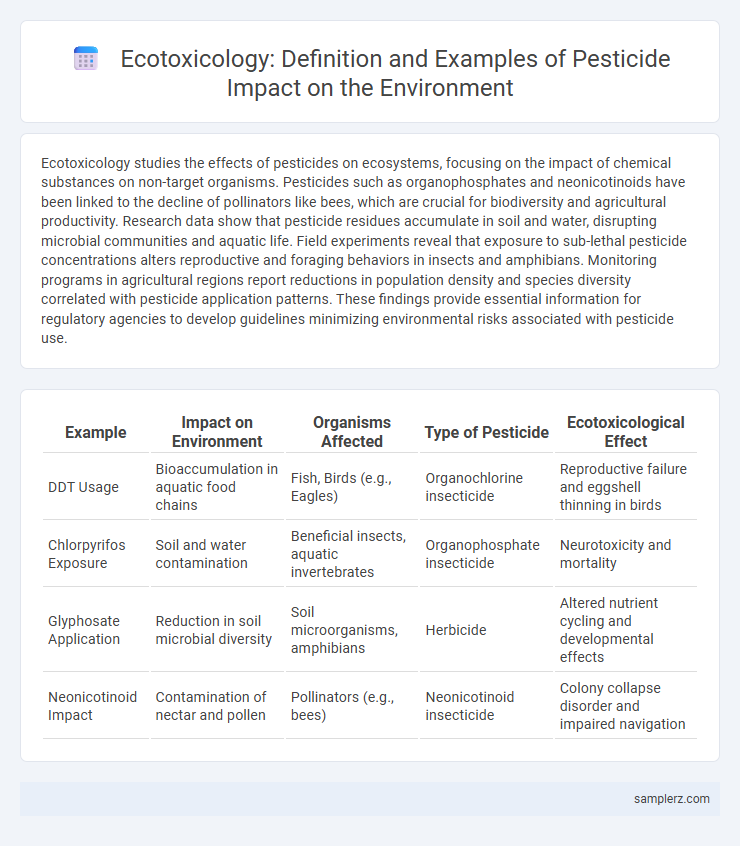Ecotoxicology studies the effects of pesticides on ecosystems, focusing on the impact of chemical substances on non-target organisms. Pesticides such as organophosphates and neonicotinoids have been linked to the decline of pollinators like bees, which are crucial for biodiversity and agricultural productivity. Research data show that pesticide residues accumulate in soil and water, disrupting microbial communities and aquatic life. Field experiments reveal that exposure to sub-lethal pesticide concentrations alters reproductive and foraging behaviors in insects and amphibians. Monitoring programs in agricultural regions report reductions in population density and species diversity correlated with pesticide application patterns. These findings provide essential information for regulatory agencies to develop guidelines minimizing environmental risks associated with pesticide use.
Table of Comparison
| Example | Impact on Environment | Organisms Affected | Type of Pesticide | Ecotoxicological Effect |
|---|---|---|---|---|
| DDT Usage | Bioaccumulation in aquatic food chains | Fish, Birds (e.g., Eagles) | Organochlorine insecticide | Reproductive failure and eggshell thinning in birds |
| Chlorpyrifos Exposure | Soil and water contamination | Beneficial insects, aquatic invertebrates | Organophosphate insecticide | Neurotoxicity and mortality |
| Glyphosate Application | Reduction in soil microbial diversity | Soil microorganisms, amphibians | Herbicide | Altered nutrient cycling and developmental effects |
| Neonicotinoid Impact | Contamination of nectar and pollen | Pollinators (e.g., bees) | Neonicotinoid insecticide | Colony collapse disorder and impaired navigation |
Overview of Ecotoxicology and Pesticides
Ecotoxicology studies the toxic effects of pesticides on non-target organisms like bees, aquatic life, and soil microbes, revealing how chemical residues disrupt ecosystems. Pesticide exposure often leads to bioaccumulation, impaired reproduction, and behavioral changes in wildlife, highlighting risks to biodiversity and food safety. Monitoring pesticide contamination in water and soil is crucial for assessing environmental health and implementing sustainable pest management practices.
Key Pathways of Pesticide Entry into Ecosystems
Pesticides enter ecosystems primarily through runoff, leaching, and atmospheric deposition, profoundly affecting aquatic and terrestrial organisms. Runoff transports pesticide residues from agricultural fields into nearby water bodies, leading to bioaccumulation in aquatic species and disruption of food webs. Leaching causes contamination of groundwater supplies, while atmospheric deposition spreads pesticides over wide areas, impacting non-target habitats and biodiversity.
Case Studies: Pesticide Contamination in Aquatic Habitats
Pesticide contamination in aquatic habitats has led to significant ecotoxicological effects, exemplified by studies on organophosphate exposure in freshwater ecosystems. These case studies reveal disruptions in fish reproductive cycles and declines in amphibian populations due to bioaccumulation of toxic chemicals. Monitoring data from regions like the Mississippi River basin highlight elevated pesticide residues correlating with reduced biodiversity and altered aquatic food webs.
Impact of Pesticides on Pollinators: Bees and Butterflies
Pesticides such as neonicotinoids disrupt the nervous systems of pollinators like bees and butterflies, leading to impaired foraging behavior, navigation, and reproduction. Declines in pollinator populations directly affect ecosystem services, including the pollination of crops and wild plants, endangering biodiversity and agricultural productivity. Monitoring pesticide residue levels in habitats and studying their sub-lethal effects on pollinator health are critical components of ecotoxicology research aimed at mitigating these impacts.
Bioaccumulation of Pesticides in Food Chains
Pesticides such as organochlorines persist in ecosystems and bioaccumulate in organisms, leading to higher concentrations in predators at the top of food chains. This bioaccumulation disrupts aquatic and terrestrial ecosystems by causing toxicity in fish, birds, and mammals, ultimately affecting biodiversity and ecosystem health. Monitoring pesticide residues in trophic levels is essential for assessing ecotoxicological risks and establishing regulatory policies.
Effects of Pesticides on Soil Microbial Communities
Pesticides significantly alter soil microbial communities by reducing microbial diversity and disrupting nutrient cycling processes essential for soil health. Studies reveal that exposure to common pesticides like organophosphates and neonicotinoids decreases beneficial bacteria and fungi populations, impairing organic matter decomposition and nitrogen fixation. These ecological imbalances compromise soil fertility and ecosystem resilience, highlighting the critical need for sustainable pest management practices.
Amphibian Population Declines Linked to Pesticide Exposure
Pesticide exposure significantly contributes to amphibian population declines by disrupting endocrine systems and increasing mortality rates during key developmental stages. Specific studies reveal that chemicals such as atrazine and chlorpyrifos impair amphibian immune function and reproductive success, exacerbating vulnerability to diseases and environmental changes. Ongoing ecotoxicological research emphasizes the urgent need for safer pesticide regulations to protect these sensitive species and maintain ecosystem balance.
Pesticide-Driven Disruption of Aquatic Food Webs
Pesticide-driven disruption of aquatic food webs occurs when chemical exposure reduces populations of key invertebrates, such as zooplankton, leading to imbalanced predator-prey relationships. These toxic substances bioaccumulate in higher trophic levels, including fish and amphibians, impairing reproductive success and survival rates. Continuous pesticide contamination alters nutrient cycling and ecosystem functioning, causing long-term biodiversity loss in freshwater habitats.
Regulatory Responses to Pesticide Ecotoxicity
Regulatory responses to pesticide ecotoxicity include strict evaluation protocols established by agencies such as the Environmental Protection Agency (EPA) and the European Chemicals Agency (ECHA), which require comprehensive ecotoxicological testing to assess impacts on non-target species like pollinators and aquatic organisms. Risk assessment frameworks integrate data from bioaccumulation, acute toxicity, and chronic exposure studies to enforce usage restrictions, buffer zones, and permissible residue limits. These regulations drive the adoption of safer pesticide alternatives and promote integrated pest management strategies to mitigate long-term environmental damage.
Strategies for Mitigating Pesticide Impacts on the Environment
Implementing integrated pest management (IPM) strategies reduces reliance on chemical pesticides, minimizing ecotoxicological risks to non-target species and ecosystems. Utilizing biopesticides derived from natural organisms decreases environmental persistence and toxicity compared to synthetic chemicals. Buffer zones and vegetation strips along water bodies act as physical barriers, preventing pesticide runoff and protecting aquatic life from contamination.

example of ecotoxicology in pesticide impact Infographic
 samplerz.com
samplerz.com